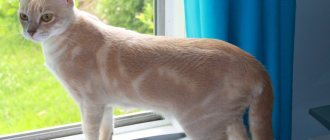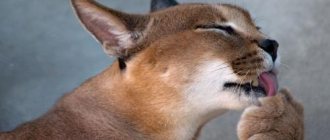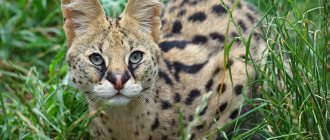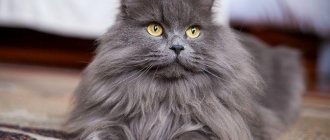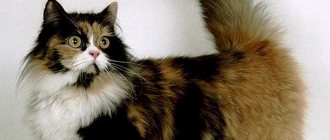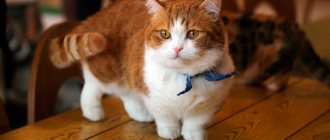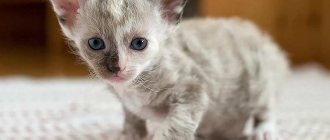Serval cats are carnivorous mammals from the cat family. They are called shrubby because the animals' normal habitat is not always forested. Most species prefer savannas, bushes, and semi-deserts. However, there are still those who live in forests.
Serval cats are carnivorous mammals from the cat family.
Origin, description and appearance
The Serval cat breed is one of the rarest, and therefore enjoys well-deserved respect among connoisseurs.
The Serval is a cat that has been tamed and made the main decoration of any home.
The distinctive factor is its special color, visually reminiscent of a cheetah, and grace.
Servals are wild cats that live throughout Africa, except the Sahara Desert. People managed to domesticate them.
Appearance:
- short hair;
- color features - numerous dark spots;
- the height of an adult animal reaches 0.6 m at the withers;
- body length - about 1.1 m;
- tail length approximately 30 cm;
- paws are long, thin;
- medium sized head;
- the ears are large and wide, rounded at the top (at the base at the top, each ear is covered with thick light fur);
- the eyes are almond-shaped, curved in the upper part;
- the nose is large and pronounced.
Standard colors for the breed:
- light beige (dark spots);
- beige-red with dark spots or stripes.
The chest and belly are light (milky or white, without spots). Average weight – 10-18 kg.
Interesting Facts
Official recognition of servals as a domesticated cat breed took place in the middle of the 19th century, so a lot of interesting things are already known about them:
- Due to the fact that these animals often chose dense, tall bushes to make their “home”, they are also called bush cats.
- Servals can communicate using a variety of sounds. They express emotions and attract attention by purring, growling, squawking and even chirping.
- In the wild, bush cats lead a solitary lifestyle. The average area occupied by 1 serval is 4-20 km2.
Breed character and habits
The Serval breed is a born predator. Home is his territory, which he constantly explores.
The Serval breed is a born predator.
Distinctive character traits:
- curiosity;
- speed of reaction;
- mobility;
- ability to run fast;
- agility (the pet is able to jump to a height of up to 3.5 meters).
The kitten must learn to be affectionate. This should be done from 2-3 months.
Behavioral characteristics comparable to a dog:
- the cat can walk on a leash;
- bring small items to the owner.
The cat shows devotion and affection only to one person ; the rest of the family will be content with a neutral or friendly attitude.
Due to its wild nature, the animal's character is independent but gentle. The manifestation of affection for the owner is expressed by purring. Cats also love to rub against your legs and jump on your hands.
Important rule! It is advisable that there are no other animals in the house (servals can hunt birds or small rodents) or children (cats cannot tolerate loud or sharp sounds, squeezing and snuggling).
A cat shows devotion and affection only to one person.
It is prohibited:
- beat animals;
- kept in captivity (in cages or small pens);
- hold in your arms for a long time against your will.
Important! In order for the serval to understand that the boss is the owner, he should not be allowed to bite his arms or legs, even during play.
Cats that look like pumas
Abyssinians
A recreated ancient breed based on the indigenous breeds of Africa and Asia.
Chausie
The cat weighs about 10 kg, it is somewhat similar to a chito, but it is the result of crossing a wild jungle cat (swamp lynx) and an Abyssinian cat. Undoubtedly, it resembles a mountain lion - a puma.
Care and maintenance
Attention must be paid to care and maintenance. Since the pet’s body and overall dimensions are large, it is recommended that cats be purchased by those who can provide them with a spacious room.
Be sure to read:
Is it possible to tame a Pallas's cat: how to keep and care for it, possible problems, what not to do
Small rooms or standard apartments can cause aggression - nature will take over, and the cat will begin to damage the furniture and scratch corners.
Tray training occurs in 1-2 days. A regular toilet won't do. You need a large tray with sides. Filler – pebbles, silica gel.
Hygiene
Hygiene procedures are an integral element of caring for any cat. Bathing is one of the Serval's favorite activities, which distinguishes it from 99% of other cat breeds.
Tray training occurs in 1-2 days
It is recommended to bathe your pet once a week. A person should also remember that short but warm hair will need to be combed regularly (once a week). Hygiene involves cleaning the ears with cotton swabs.
Diet and feeding
Since the serval is a predator, its main food is meat in various forms. The diet should include poultry (chicken, turkey) and offal.
The animal should receive calcium from special complexes containing vitamins and minerals (it is not advisable to include milk in the diet).
If dry food is used, then regular drinking water should always be freely available. Feeding is done 2 times a day. To control weight, it is recommended to arrange fasting days once a month (exclude feeding for a day).
Education and training
A high IQ allows for training. Servals are capable of learning and can perform tricks of varying complexity: high and long jumps, carrying objects in their teeth, etc.
It is recommended to start education from the very first days. If cats start scratching furniture or wallpaper, you will need to buy a scratching post and treat the damaged areas with a special compound to stop them from spoiling things.
Life expectancy and typical diseases
The life expectancy of representatives of this breed at home reaches 20 years.
Servals do not have any typical diseases.
Servals do not have any typical diseases. Regular vaccination is recommended.
Be sure to read:
A cat that looks like a lynx: the best domestic and exotic breeds, features of their maintenance
The most common health problems:
- hypothermia;
- diarrhea and dehydration;
- injury.
Since cats are very active and love to jump, in most cases paw injuries occur (usually in kittens, since their skeletal system is not yet fully formed).
Castration and sterilization
When choosing this breed, you need to remember that both the male and the female are capable of marking their territory. The liquid has a strong unpleasant odor, which is very difficult to get rid of.
That is why for representatives of this breed castration and sterilization are mandatory procedures if the animals are not used for breeding. Age when surgery can be performed: 12-14 months for females and 7-8 months for males.
Basic moments
- Savannahs belong to the category of hybrid animals obtained by crossing a male African Serval with a Bengal cat.
- The main character trait of Savannahs is their exceptional devotion to their owner, which makes them very similar to dogs.
- Cats of this species are distinguished by a phenomenal memory, a lively mind and a passion for an active lifestyle.
- Savannahs are able to peacefully coexist in the same territory with other animals, but they prefer to build friendly relationships with dogs.
- Savannahs suffer from loneliness and will not take root in apartments with a shortage of free space.
- They easily get used to the harness, which makes it possible to walk the cat on a leash.
- In 2007, a new breed of Asher was introduced, which in reality turned out to be a representative of the Savannah breed. This has caused a little confusion, due to which many consider the Asherah to be a separate breed.
Savannah , also known as Ashera , is a smaller copy of a cheetah, possessing remarkable intelligence, with a price tag equivalent to the cost of a one-room apartment in the province. In the early 2000s, these representatives of the feline elite found themselves at the epicenter of a huge scandal, which did not affect their value at all. A pet of the Savannah breed still remains a kind of indicator of prestige and a measure of the success of its owner, so it is rare to see a spotted cat proudly walking on a leash on Russian streets.
Breeding
When choosing this breed, you need to remember that both males and females are capable of marking their territory.
Sexual maturity in representatives of the cat family begins at 1.5 years. During this period, they become more active and may exhibit aggressive behavior, so it is necessary to closely monitor the animal.
Mating and partner selection
Keeping a cat assumes that if castration (sterilization for cats) is not carried out, then you will need to think about mating. Servals are able to mate with ordinary cats, as well as caracals.
The choice of a partner depends on the goals - to preserve the breed and for breeding purposes, it is recommended to choose only a serval for mating.
Pregnancy and childbirth
The age at which pregnancy can begin is about one and a half years. The gestation period is 65-75 days. There can be 1-3 kittens in a litter.
The birth process in 95% of cases goes smoothly and without complications, but contacting a veterinarian is mandatory to exclude any complications for the mother and babies.
Savannah price
It is also immediately worth noting why the price of these animals is so high. This is due to the fact that breeding savannas is a very troublesome and time-consuming business. After all, you need to cross two different breeds with different gestation periods (domestic cats have less), and this implies premature kittens and a high mortality rate. They require especially careful care. You should also understand that the babies will be quite large due to the nature of the breed, so natural childbirth is not always possible. A caesarean section is often necessary, which is an expensive operation.
Characteristics of this breed
The serval is a noisy and active animal . It requires increased attention and loves to spend time playing games. You can go for a walk with him using a leash.
Size and weight gain
The size of the animal is large - length 1.1 m, height more than 1.5 m. Weight gain occurs quickly, so it is important to monitor nutrition.
Shedding
Short hair does not leave marks if combed out in a timely manner. Shedding occurs in the autumn, then it is recommended to use a special brush 2-3 times a week.
Allergy
Servals are hypoallergenic breeds. In 95% of cases there is no negative reaction from the body.
Be sure to read:
Is it possible to tame a Pallas's cat: how to keep and care for it, possible problems, what not to do
Who are ushers
Ashera cats are purely an advertising product and have not yet been recognized by any felinological association. In 2007, the American cat presented to the world giant leopard cats, which were allegedly born as a result of complex genetic experiments. According to the owner of the company, Simon Brody, the domestic cat, the African serval and the Asian leopard cat donated their genes to the new breed. Well, the main selling legend of Asher was their complete hypoallergenicity.
Where to buy and how much does a kitten cost?
Serval kitten
It is recommended to purchase a kitten from trusted breeders or a nursery. The breed is rare and expensive, so there is a risk of encountering scammers.
You can avoid problems by contacting professional breeders who will issue all supporting documents.
What to pay attention to
When purchasing, you should pay attention to the characteristic features of the breed - dimensions, appearance, color.
You also need to look at the behavior of the animal - if it is healthy, it will be playful and quick, the eyes should be light and clear without clouding or discharge.
Approximate cost of a kitten
The price of the animal varies. It depends on the purity of the breed (a spot on the chest reduces the cost), and age. The cost starts from 150,000 rubles and reaches 500,000 rubles and above.
Cats that look like lynx
Pikibob
Breeders used North American short-tailed forest cats to create a small version of the lynx.
Kurilian Bobtail
What makes this breed look like a lynx is its short tail and tufts on its ears.
Maine Coon
Giant cats with tufted ears. The shape of the head is very similar to that of a lynx.
Norwegian forest
Powerful bones, wild cat muscles and tufted ears.
Caracal
The desert lynx is a wild cat that is bred in nurseries for domestic keeping.
Caraquet
A fairly new cross between the caracal and the domestic cat that is gaining popularity. Such a cat can weigh up to 15 kg.
This is interesting: TOP 10 medium-sized dog breeds - list, names, weight, photos and descriptions
Table: pros and cons of the breed
The advantages and disadvantages of the Serval breed are presented in the table:
| pros | Minuses |
| Exotic wild color | Large size (needs spacious housing) |
| High IQ (ability to learn) | Rancor and resentment |
| High life expectancy – up to 20 years | Strong odor of genital secretions (requires castration or sterilization unless diluted) |
| Love for water procedures | Do not keep small breeds of dogs or rodents together (they can become prey for a predator) |
| Devotion and activity | 30% of vaccines are not used |
| Absence of characteristic diseases | The basis of the diet is meat (it is necessary to feed up to 1 kg daily) |
| Possibility of walking on a leash | High price |
Colors
This breed can have several types of colors:
- It can be a black spotted tabby (has contrasting black spots).
- Black, smoky or with shades of gray (has ghost mottledness).
Despite the color, the spots are always the same; they should have a round shape, slightly elongated only in a horizontal position. The presence of a dark path that comes from the inner corners of the eyes is very much appreciated.
But with all the advantages, there is, unfortunately, a drawback in their coloring - these are ordinary white, red, and spotted cats. However, in ordinary spotted cats, the spots are elongated in a vertical direction, which is not typical for representatives of the Serengeti.
Pixie Bob
Size: 8-11 lbs.
Lifespan: 15 years
Personality: Loyal, sociable, playful
Pixie Bob was the result of an unplanned breeding between a bobcat and a barn. While he looks like he belongs in the wild, the pixie bob is gentle and affectionate. He is extremely loyal to his family and gets along with everyone he meets, including dogs.
Click on the image to view full size
History of origin
The first savannas were born in the 80s. last century from the unusual union of a domestic cat and a serval - a strong and freedom-loving animal. Breeders sought to breed a cat that looked as close as possible to a wild one.
The first results of numerous crossings were obtained in 1986. Two kittens were born. They were distinguished from domestic cats by their spotted color, characteristic wild look and very large size.
In order to obtain such an unusual breed, breeders had to make a lot of effort. Not only domestic cats and servals took part in the crossing, but also other representatives of the animal world - Bengal and Siamese cats, Egyptian Mau.
The kittens were immediately accepted into TICA - the International Cat Association. But the breed was officially registered only at the beginning of the two thousandth. Hundreds of people around the world instantly became her fans. But buying an exotic pet is not so easy. This breed is still very rare due to some difficulties in obtaining offspring.
Bombay
Size: 8-12 lbs.
Lifespan: 15-20 years
Personality: Tolerant, calm, playful
Bombay looks like a miniature black panther, but he is not at all ferocious. He prefers to play and relax around the house in the company of his people. Bombay is calm, affectionate and tolerant of dogs and other people. However, since he enjoys being the center of attention, he may become jealous of other cats.
Click on the image to view full size
Serengeti
Size: 8-15 lbs.
Lifespan: 13-15 years
Personality: Active, loves heights, friendly
This designer breed was created in 1994 by Karen Sausman, a conservation biologist who selectively bred Shorthairs and Bengals together to create the wild marks you see today. The Serengeti is a friendly cat that loves to jump and climb. If this cat doesn't get stimulation in the form of human interaction or interactive play, she will find her own entertainment (like destroying your house).
Click on the image to view full size
Asian tabby
This breed is of British origin, bred in the 1980s. To obtain it, a Burmese cat was crossed with a Persian chinchilla. The result is a short-haired animal, strong, with a good physique.
On her neck there is a spot - a necklace, and her eyes and nose with mouth are also outlined. The tail is tapered, with ring-shaped spots.
Painting comes with 4 types of patterns:
- spotted;
- marble (with stripes and stains);
- brindle;
- ticked (with a pattern on the face and striped hairs on the body).
Colors range from blue to cream and chocolate. The ears are erect, the eyes are almond-shaped, the irises are golden, and there are cheekbones. The character is friendly, gentle, communicates with people and other inhabitants of the house.
Leopard-colored cats are a mixture of various breeds, including wild ones. The most important thing in communicating with them is to try to find mutual understanding. A close study of your pet will help you find a common language and create comfort for everyone.
American Bobtail
Size: 7-16 lbs.
Lifespan: 13-15 years
Personality: Friendly, intelligent, loyal, calm
This wild-looking cat is a softie at heart. He will appeal to anyone who gives him attention and enjoys company, be it people, other cats or even dogs. He is calm, friendly and adaptable. They are wonderful travelers and therapy cats because they get along so well with everyone and have a calm and friendly personality. If you've ever dreamed of having a cat with the personality of a dog, the American Bobtail is the cat for you.
Egyptian Mau
Size: 7-9 lbs.
Lifespan: 13-16 years
Personality: I love heights, active, strong-willed
The Egyptian Mau has long, slender legs and the personality of an Egyptian god/goddess. They love to climb and hang out at high altitudes to observe their kingdom and items. They are also fast runners and require a lot of space to run and play.
Click on the image to view full size

